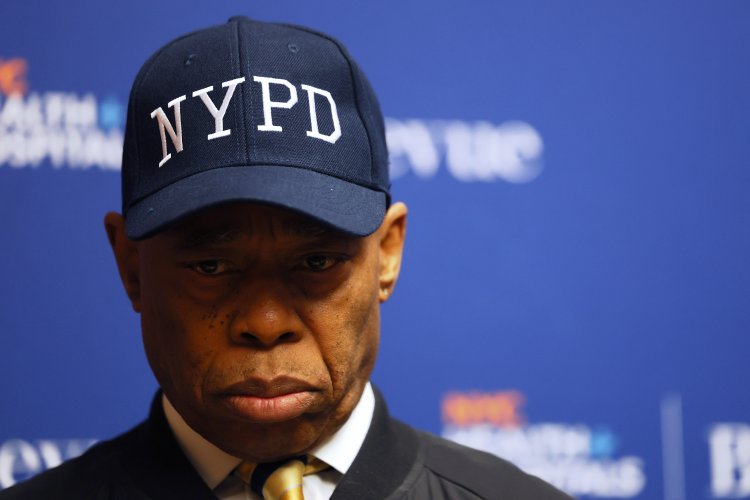Eric Adams Promotes Decrease in Crime, But Statistical Data Suggests Otherwise
Although murders and shootings have significantly decreased, there has been a consistent rise in overall crime during the New York City mayor’s time in office.

This feeling is substantiated by the NYPD's own statistics.
Under Adams, total crime has risen each year — a development surprising for a former police captain who campaigned on a promise to reduce lawlessness — even as New York City has ranked among the safest large cities in the nation during his tenure.
Since Adams assumed office on January 1, 2022, murder rates have dropped by 22 percent, and shootings decreased by over 40 percent. However, every other category labeled as "major" by the police department has seen increases. According to the latest year-end NYPD statistics, felony assaults surged by 29 percent, car thefts rose by 36 percent, and robberies climbed by 20 percent from the end of 2021 to the end of last year.
Newly released data across all 34 crime categories, including minor infractions like trespassing and graffiti, indicates that total infractions grew by 28 percent, escalating from 454,404 at the end of 2021 to 580,338 at the conclusion of 2024.
This rise in crime mirrors levels not witnessed in a decade, leading many New Yorkers to take notice.
“People feel the small crimes,” said Paul Reeping, director of research at the policy journal Vital City. “And when they build up over time, they are going to feel unsafe.”
This perplexing situation arises for Adams, a retired police captain who won the mayoral race promising to tackle disorder in a city battered by the pandemic. As he seeks reelection this year, he must grapple with a legacy that feels at odds with his original platform.
Nevertheless, Adams points to some accomplishments: during the first quarter of this year, both shootings and transit crimes reached record lows, and murders continue to trend downward toward historic lows. Reports show a decrease in burglaries, robberies, and thefts, including vehicle thefts, over the past year. Additionally, the pace of overall crime growth has started to decelerate.
Adams argues that he inherited a city grappling with a pandemic-related rise in criminal activity, which aligns with trends observed nationwide.
However, analysis conducted by PMG reveals a city that may not feel as secure as it did pre-Covid or even when Adams took office two years ago. He is hopeful that voters will trust his extensive experience in law enforcement and hold his Democratic opponents accountable for supporting policies he believes hinder police efforts.
“We know our success in numbers must match the success in how people are feeling. And part of that is we're asking all of you out there and in the media: Let's not find the worst thing that happens in our city in a day and make it seem like it defines our city,” Adams stated during a recent briefing. “Let's highlight how well we have turned the city around.”
The increase in crime is occurring amid turmoil within the upper ranks of the country's largest police department. Adams, who based his 2021 campaign almost solely on reducing crime, has cycled through three police commissioners who either resigned or were dismissed. His fourth commissioner, Jessica Tisch, has implemented major leadership reforms, overseen some improved crime data, and introduced a quality-of-life division focused on low-level offenses.
New York City mayors generally prioritize their public safety initiatives around the seven most serious crimes, and Adams is no different. He has touted positive trends while attributing fear in the five boroughs to sensationalized headlines about subway violence and daylight homicides.
However, PMG's review of NYPD data shows that increases in “non-major” crimes have been just as pronounced as rises in the seven major categories — an overlooked trend contributing to New Yorkers' lingering sense of anxiety.
This broad category encompasses “non-major” felonies that include weapon possession, stolen property, and illegal substances, with nearly all showing growth during Adams’ administration.
The classification of violations, which encompasses harassment and disorderly conduct, reflects a similar trend, alongside misdemeanors like sexual misconduct and theft.
Particularly alarming, felony and misdemeanor assaults have climbed to levels not observed since 1998, according to a Vital City report that examines the connection between low-level offenses and public safety concerns. Increasingly, these assaults are perpetrated by strangers, with around 40 percent classified as felony assaults last year.
“There’s a sense that there isn't a strong management of the city's bureaucracy in tackling these issues,” remarked Basil Smikle Jr., a former leader of the state Democratic Party. “That has to be addressed head-on.”
City Hall has defended the administration's progress.
“Since taking office, Mayor Adams has made sure that we use every tool in our toolbox to keep New Yorkers safe, and the results speak for themselves: overall crime citywide was down last year and is down by double digits year-to-date,” spokesperson Kayla Mamelak Altus explained, referencing major felonies.
Data shows that between 2023 and 2024, five of the seven major felonies declined, with assault and rape as the exceptions; the latter being influenced by new reporting requirements under the “Rape is Rape Act.”
Adams recently announced that first-quarter shootings were lower than in any quarter since the NYPD's Compstat data tracking began in the 1990s. Murders were reported at their second-lowest figure during the same timeframe. Additionally, excluding the pandemic, the city experienced its lowest first-quarter transit crime figures — following two consecutive years of decline.
“[Six] straight months of crime reduction is due to the tireless work of the men and women who put that blue uniform on every day and protect the people of this city,” Adams stated when unveiling those statistics. “This is how you raise healthy children and families in a safe environment.”
An NYPD representative noted that under Adams, enforcement has significantly increased: arrests surged from 155,506 at the end of 2021 to 260,501 at the close of last year, a rise of nearly 70 percent. Lower-level summonses also rose by about 225 percent during the same period. Additionally, Adams often highlights efforts to confiscate illegal firearms.
However, the mayor's team argues that progress has been hindered by changes to state bail and discovery laws enacted in 2019 that are still being felt.
“Make no mistake, these massive strides have been made thanks to the Adams administration’s dedication to public safety and in spite of countless issues within our current criminal justice system, which has produced a revolving door of repeat offenders,” Mamelak Altus commented.
Determining the role of recidivism in the city's increasing crime rate is complex.
The NYPD shared statistics tracking repeat offenders for six types of crimes pre- and post-bail reform. In the first quarter of 2018, about 2,500 individuals were arrested more than three times for the same offense; by this year's first quarter, that number increased to over 4,500, a 73 percent rise.
However, the NYPD did not disclose how many crimes these individuals allegedly committed.
For instance, in the first quarter of this year, there were approximately 2,500 individuals arrested for shoplifting, but over 100,000 shoplifting incidents were recorded overall.
Some advocates for criminal justice reform argue that the impact of the 2019 state laws on increasing crime is overstated, complicating the narrative Adams seeks to convey.
Advocates from the New York Civil Liberties Union argue that rising crime figures are inflated due to heightened policing measures and increased arrests for minor offenses impacting quality of life.
“It's typically the neighborhoods that are Black and Latino where you see disproportionate enforcement of low-level offenses,” said executive director Donna Lieberman. “When you put police on the street, they tend to make more arrests, not because there's more crime, but because they're making more arrests.”
In this complicated landscape, candidates aiming to deny Adams a second term in the upcoming mayoral election have taken note of public sentiment regarding safety.
With polls indicating public safety as a key concern among voters, candidates with left-leaning platforms have softened their previous views on law enforcement.
Except for Assemblymember Zohran Mamdani, the majority of Democratic candidates plan to bolster the NYPD's personnel count. City Comptroller Brad Lander, who once opposed a City Council budget for lacking sufficient defunding of the NYPD, has committed to supporting Tisch, the staunch Adams appointee who has voiced strong opposition to bail reform.
Frontrunner Andrew Cuomo has sought to capitalize on voters' safety fears, portraying a picture of a city in crisis.
The reality is, however, more nuanced.
Not every neighborhood in New York City has the same level of safety. The Bronx continues to have the highest murder rate in the city. Yet, overall, New Yorkers faced a 1.3 in 10 million daily chance of being a murder victim and a 10 in 1 million chance of being assaulted in 2024, according to Vital City. In comparison, Los Angeles—America’s second most populous city—has a murder rate nearly double that of New York's five boroughs.
“The average New Yorker would believe that they’re living in a city that is out of control — that is not the reality,” Adams remarked earlier this year. “We know that we are doing a good job in fighting crime, as the numbers would show.”
Lucas Dupont for TROIB News












